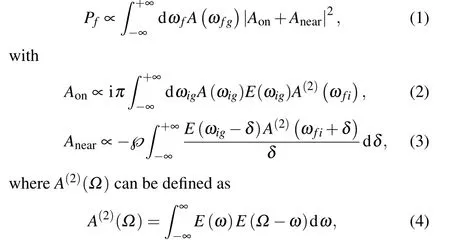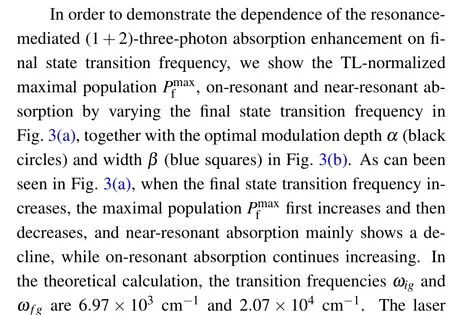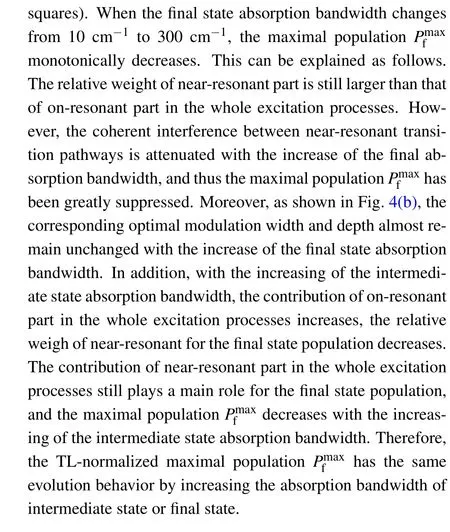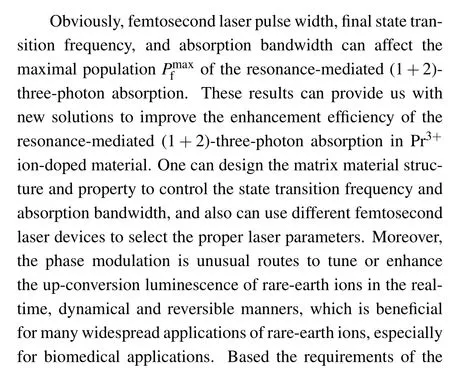Simulating the resonance-mediated(1+2)-three-photon absorption enhancement in Pr3+ions by a rectangle phase modulation
2022-06-29WenjingCheng程文静YuanLi李媛HongzhenQiao乔红贞MengWang王蒙ShaoshuoMa马绍朔FangjieShu舒方杰ChuanqiXie解传奇andGuoLiang梁果
Wenjing Cheng(程文静) Yuan Li(李媛) Hongzhen Qiao(乔红贞) Meng Wang(王蒙) Shaoshuo Ma(马绍朔)Fangjie Shu(舒方杰) Chuanqi Xie(解传奇) and Guo Liang(梁果)
1Henan Province Engineering Research Center of Microcavity and Photoelectric Intelligent Sensing,School of Electronics and Electrical Engineering,Shangqiu Normal University,Shangqiu 476000,China
2Department of Ophthalmology,First People’s Hospital of Shangqiu,Shangqiu 476000,China
3The Key Laboratory of Weak Light Nonlinear Photonics Nankai University of Ministry of Education,Tianjin 300457,China
Keywords: coherent quantum control,femtosecond pulse shaping,three-photon absorption,rare-earth ions
1. Introduction
The rare-earth ions doped materials have unique optical properties, and have been used in laser sources,[1]fiber optic communications,[2]color displays,[3]biolabeling and biomedical sensors.[4,5]The Pr3+ion has relatively wide absorption band in the vis-NIR regions, and has been used as function photonic materials like fiber optical communication,[6,7]lasers,[8,9]LEDs,[10]field-emission display or photoluminescence devices.[11]The Pr3+ion is an important activator with several meta-stable states, which offer stimulated emissions in blue, green, red and infrared regions.[12]In order to improve the luminescence efficiency of Pr3+ions, many researchers have made great effects to propose some different schemes. Hanet al.have increased fluorescence to 27-fold in comparison to K3Lu(PO4)2: Pr3+by introducing the Gd3+ions into the lattice.[13]Gateset al.have enhanced visibleto-ultraviolet upconversion in the phosphor Y2SiO5:Pr3+by cooping Li+ion.[14]The red emission in NaGdTiO4:Pr3+can be increased with the increasing temperature from 77 K to 350 K.[15]Moreover,Tianet al.have observed that ferroelectric remanent polarization remarkably enhances the photoluminescence intensity of Pr3+-doped(Bi0.5Na0.5)TiO3ceramic samples.[16]However, these methods for enhancing luminescence efficiency of rare-earth-doped materials are still limited.
The shaped femtosecond pulse is an effective method to manipulate the multi-photon absorption by modulating the constructive or destructive interference between different excitation pathways in atoms,[17,18]molecules,[19,20]and condensed state system.[21]For example, the shaped pulse withπphase modulation has been used to enhance or suppress the (1+1) resonance-mediated two-photon absorption in Rb atom and (2+1)-resonance-mediated three-photon absorption in Na atom.[18,22]Zhanget al.has demonstrated that the single-photon fluorescence of IR 125 can be modulated by the polarization modulation of femtosecond laser field.[23]Recently, with the development of the femtosecond pulse shaping technique, the femtosecond pulse has been changed as almost arbitrary temporal distribution by controlling the laser spectral phase, amplitude and polarization.[24]The upconversion luminescence of rare-earth ions is a nonlinear optical phenomenon, which convert two or multiple low energy photons into one high energy photon via two-photon or multi-photon absorption process. Researchers have proposed some pulse shaping methods to modulate upconversion luminescence of rare earth ions.[25–27]The upconversion luminescence of Dy3+ion doped glass can be enhanced by the intermediated femtosecond laser field with aπphase modulation.[25]Theπphase modulation has been used to enhance and suppress the single and two-photon fluorescence in Er3+ions.[26]The green and red up-conversion fluorescence in Er3+-doped NaYF4nanocrystals can be manipulated by square phase modulation.[27]These results illustrate that the shaped femtosecond pulse is an effective tool to modulate the up-conversion luminescence of rare-earth ions.
In this paper,we theoretically study the up-conversion luminescence control behaviors in Pr3+ions by the rectangle phase modulation of the femtosecond laser field. The theoretical results show that the resonance-mediated(1+2)-threephoton absorption in Pr3+ions can be effectively enhanced by the rectangle phase modulation, and the absorption enhancement efficiency is correlated with the laser pulse width, final state transition frequency and absorption bandwidths. The absorption enhancement efficiency has been decreased under the lager laser pulse width and energy level absorption bandwidths, while the absorption enhancement efficiency first increases and then decreases with the increase of the final state transition frequency.These research can provide a clear physical picture for understanding and controlling the multi-photon absorption in rare-earth ions,and can provide theoretical guidance for the related experimental works.
2. Theoretical model
Figure 1(a) show the up-conversion luminescence processes of Pr3+ions via the resonance-mediated(1+2)-threephoton absorption. We use the ground state|g〉, intermediate state|i〉and final state|f〉to represent these states3H4,3F4, and3P0, respectively. For the femtosecond laser field,its spectral bandwidth is always larger than absorption bandwidth of intermediate state|i〉. The electrons in ground state|g〉can be pumped to the final state|f〉via the intermediate state|i〉, which is called the resonance-mediated (1+2)-three-photon absorption process. The resonance-mediated(1+2)-three-photon absorption includes both on-resonant and near-resonant three-photon absorption. For on-resonant part,the ground state electrons are first pumped to the intermediate state|i〉by absorbing one photon with the frequency of|g〉 →|i〉, and then is further pumped to the final state|f〉by absorbing two photons with the photon frequency sum of|i〉→|f〉. For near-resonant part, the ground state electrons can absorb three photons and reach the final state|f〉without through the intermediate state|i〉, where the frequency sum of these three photons is equal to the transition frequency of|g〉→|f〉. Then, the electrons in the final state|f〉can relax to the lower states3H6,3H5, and3H4, and further generate the up-conversion fluorescence via the transition processes of3P0→3H6,3P0→3H5,and3P0→3H4.
Based on theoretical research method of the resonancemediated (2+1)-three-photon absorption in Na atom,[22]we construct the third order perturbation theory to study the resonance-mediated (1+2)-three-photon absorption of Pr3+ion under the low femtosecond laser field excitation. The resonance-mediated (1+2)-three-photon absorption includes the contribution of on-resonant termAonand near-resonant termAnear,and can be described in the frequency domain as

where the℘is the Cauchy’s principal value, andωigandωfgare the resonant transition frequencies of|g〉→|i〉and|g〉→|f〉.A(ωig) andA(ωfg) represent the absorption functions of the immediate state and final state,which are Gaussian shape.Moreover,δ=ωig-ωis the detuning from the excited state|i〉. The femtosecond laser field in frequency domain can be expressed asE(ω)=E0(ω)×exp[iΦ(ω)], whereE0(ω)andΦ(ω)represent the spectral amplitude and phase,respectively. SubstitutingE(ω)=E0(ω)×exp[iΦ(ω)]into Eq.(3)and(4),we can obtain

In addition,E0(ω) can be expressed by the function ofE0(ω)=exp[-ln4(ω-ω0)2/(Δω)2],ωand Δωare the central frequency and spectral width of femtosecond laser field.
The phase modulation of femtosecond laser field is an effective method to manipulate the destructive or constructive interference between different excitation pathways.[25–27]Here,a rectangle phase modulation scheme has been proposed to enhance the resonance-mediated (1+2)-three-photon absorption in Pr3+ions. Figure 1(b)show the femtosecond laser spectrum (red solid line), the intermediated state absorption spectrum (green dashed line), and the rectangle phase modulation(blue dotted line). As shown in Fig.1(b),αis depth of the rectangle phase modulation,which can be changed from 0 to 2π, andβis the width of the rectangle phase modulation.When the femtosecond laser pulse is modulated by the rectangle phase modulation, the phase of the laser spectrum under the modulation widthβis added the modulation depthα.Based on the experimental reports,[28,29]the Pr3+ions parameters are set as follows in the theoretical calculation.The transition frequency of intermediate state isωig=6.97×103cm-1,and that of final state isωfg=2.07×104cm-1. The absorption bandwidth (FWHM) of immediate state and final state are both 100 cm-1. Moreover, the femtosecond laser field in theoretical calculation is Gaussian shape with the center frequency 6.97×103cm-1,and the laser pulse widthτis 20 fs.The spectral bandwidth Δωand the pulse widthτcan satisfy Fourier transformation:τΔω=4ln2. It is obvious that the larger pulse width is corresponding the smaller laser spectral bandwidth.

Fig.1.(a)The resonance-mediated(1+2)-three-photon absorption processes with on-resonant and near-resonant excitation pathways and luminescence processes in Pr3+ ions,(b)the femtosecond laser field(red solid line)modulated by a rectangle phase (blue dotted line) with modulation depth α and modulation width β and the absorption spectrum of intermediate state(green dashed line)in Pr3+ ions.
As can be seen in Eqs. (5)–(7), the near-resonant termAnearis not only related to the opposite sign of 1/(ωig-ω)for different laser spectrum components, but also related to the phase terms eiφ(ωig-δ) and eiφ(ω)+iφ(Ω-ω)for different laser frequencies. For the transform-limited (TL) pulse with the phase term(ω)=0,the on-resonant termAonis an imaginary number,while the near-resonant termAnearis a real number. It is clear that the coherent interference cannot occur between the on-resonant and near-resonant transition pathways. Moreover,as can be seen in Eq. (6), the detuningδ=ωig-ωis positive or negative for the laser frequency compositionω <ωigorω >ωig, and the destructive interference can happen between near-resonant transition pathways. However, for the shaped pulse, the phase can play an important role for the final state population, and the rectangle phase modulation can be used to enhance the final population. In the actual experiment,the matrix material composition and preparation method always affect the absorption bandwidth and energy levels of rare earth ions by the crystal field, spin–orbit coupling and host lattice.[30,31]The energy levels of Ln3+are affected by both Coulomb force and spin–orbit coupling,and the splitting of the energy levels can be induced by the crystal field. Therefore, we discuss the influence of transition frequency and absorption bandwidth of middle state and final state. In addition, the laser parameters also affect the maximal absorption enhancement,including the laser pulse width,the laser intensity and polarization. The middle and strong laser intensity always induce high-order multi-photon process, and different polarizations of the laser field can generate the complex excitation pathways.[32,33]In this paper, we primary focus on resonance-mediated (1+2)-three-photon absorption in Pr3+ions,and discuss the effect of the laser pulse width or spectral bandwidth on the maximal absorption enhancement. Therefore,based on different situations in the actual experiment,we further analyze and discuss the influence of the laser parameters(laser pulse width or spectral bandwidth)and energy level structure(final state transition frequency,final state and intermediate state absorption bandwidth) on the maximal absorption enhancement.
3. Results and discussion



Fig.2. (a)The TL-normalized maximal population of final state (black squares),on-resonant(blue triangles)and near-resonant(red circles)absorption with the increase of the laser pulse width,(b)the corresponding optimal depth α (black circles) and width β (blue squares) of the rectangle phase modulation.



Fig.3. (a)The TL-normalized maximal population of final state x (black squares) by changing the final state transition frequency, and together with the on-resonant (blue triangles) and near-resonant (red circles) absorption;(b) the corresponding optimal depth α (black circles) and width β (blue squares)of the rectangle phase modulation.



Fig. 4. (a) The TL-normalized maximal population (black squares)as a function of the final state absorption bandwidth, and together with onresonant (blue triangles) and near-resonant (red circles) absorption, (b) the corresponding optimal depth α (black circles)and width β (blue squares)of the rectangle phase modulation.


4. Conclusion

Acknowledgments
Project supported by the National Natural Science Foundation of China (Grant Nos. 12004238 and 11764036), the Natural Science Foundation of Henan Province,China(Grant No.222102230068),and the Open Subject of the Key Laboratory of Weak Light Nonlinear Photonics of Nankai University(Grant No.OS 21-3).
猜你喜欢
杂志排行
Chinese Physics B的其它文章
- Switchable terahertz polarization converter based on VO2 metamaterial
- Data-driven parity-time-symmetric vector rogue wave solutions of multi-component nonlinear Schr¨odinger equation
- Neutron activation cross section data library
- Multi-phase field simulation of competitive grain growth for directional solidification
- A novel similarity measure for mining missing links in long-path networks
- Effects of electrical stress on the characteristics and defect behaviors in GaN-based near-ultraviolet light emitting diodes
